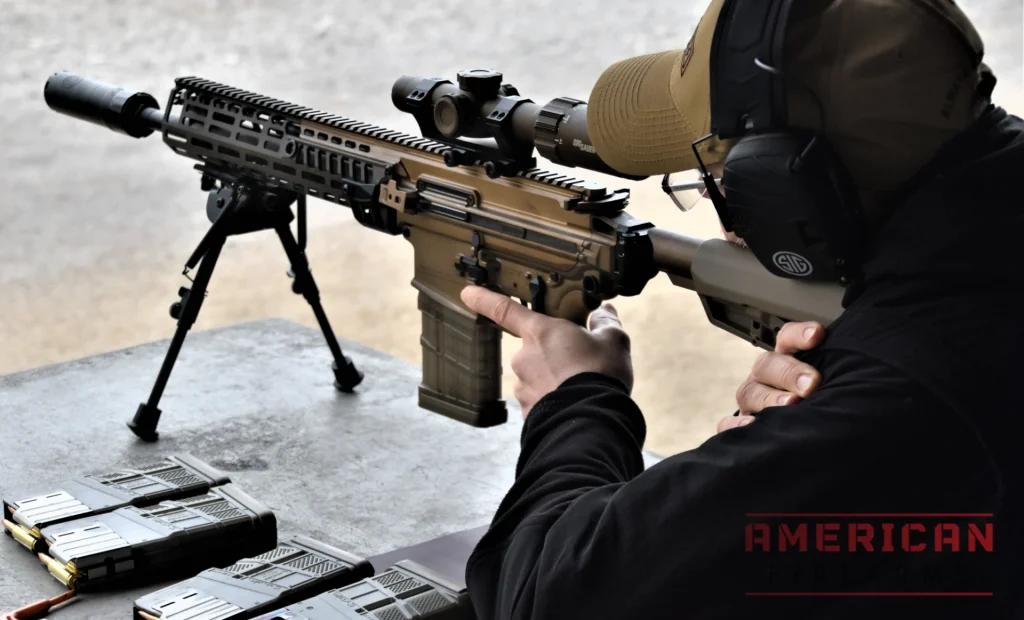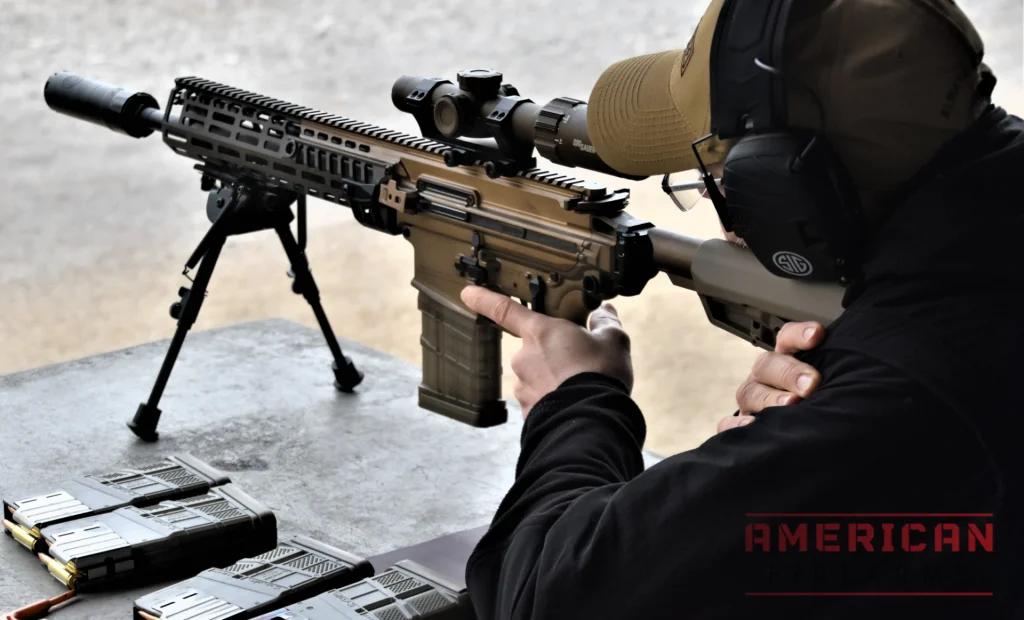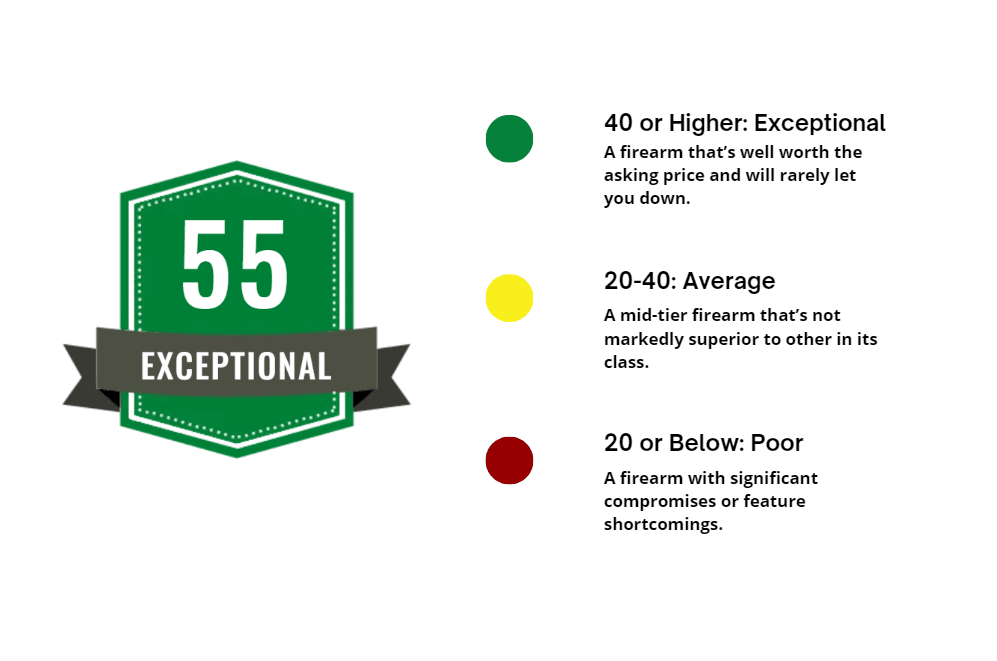
How We Test & Rate Gear
Creating helpful, reliable, authentic — and maybe even entertaining — reviews is at the core of everything we do.
How We Test & Rate Gear
Creating helpful, reliable, authentic — and maybe even entertaining — reviews is at the core of everything we do.

Every day our team tests the latest guns, accessories, apparel, and tech all across the US, and since 2006 we’ve poured untold hours into building, refining, and optimizing our testing and scoring system.
Our system is designed to create a clear and fair quantitative assessment of firearms. Using our scores as a guideline you can quickly and easily identify the firearm that best fits your needs.
Below we outline each rating factor so you can see exactly how we test and score products.
Our Scoring System
Our overall score is based on a weighted average of 6 scoring factors:

Each factor is weighted based on importance, which we combine together to calculate the overall score. No fractional points are awarded (no 4.5, for example).
And guess what? You can rate products too! Check our Most Popular Guns lists — a place where the American Firearms Community can rate and review all your favorite (or most hated) guns.
Understanding our Scoring System
For each rating criterion, we use a 1-10 point scale. The more points a firearm scores in any given criteria, the better its performance.
- 10 – Exceptional. It doesn’t get much better than this.
- 9 – Excellent. Most people will be thrilled with the performance level.
- 8 – Very Good. While there is room for improvement, it’s still better than most.
- 7 – Fair. Depending on your needs this could signal one to avoid.
- 6 – Poor. There are significant issues or shortcomings.
- 5 – Very Poor. There are multiple significant issues.
- 4 or less – Fail. Not competitive in this area.
We then aggregate these scores and display the Overall Score with our badge. This color-coded badge makes it easy for you to see how well a firearm scored at a glance.
A Perfect Score across all 6 criteria would produce a 60, but anything higher than a 40 we consider “Exceptional”, with 20-40 being “Average” and a sub-20 total score rated as “Poor”.

Accuracy
Accuracy fundamentally pertains to the firearm’s consistent ability to land shots on the intended target and to achieve tight shot groupings. Although some degree of subjectivity may come into play, efforts are made to minimize user-induced errors during the evaluation.

Here’s the scale we use to determine Accuracy:
- 9-10: Exceptional. Excels as an extremely accurate “tack-driver,” capable of tight groupings with most ammo types, epitomizing precision shooting.
- 7-8: Quality. The firearm stands out for its accuracy due to superior ergonomics, a smoother trigger, or efficient design, delivering solid performance with most ammunition brands.
- 5-6: Acceptable. The firearm shows satisfactory accuracy for general use, landing shots near the point of aim and achieving respectable groupings with at least 50% of major ammo brands.
- 3-4: Poor. The firearm has less desirable accuracy with inconsistent group sizes, showing ammo specificity and potential misalignment with factory sights. Likely fixable.
- 1-2: Fail. The firearm exhibits erratic shooting patterns with unacceptable accuracy and severe ammo selectiveness, raising significant concerns.
Ergonomics
Ergonomics refers to a firearm’s comfort, efficiency, and ease of use. How well does the gun feel and fit in the hand or stance while gripping and shooting it?
We evaluate stock design, size and weight, balance, adjustability, palm swell sizes, grip length, texture, control placement, and if this style of grip works for multiple hand sizes, lefties & righties, and shooting styles.

Here’s the scale we use to determine Ergonomics:
- 9-10: Exceptional. Fits like a glove with intuitive, easy-to-use controls, greatly enhancing shooting performance and comfort for the majority of users.
- 7-8: Quality. Comfortable for about 75% of shooters, featuring well-designed controls and possible adjustability, with only minor criticisms regarding shape, texture, and controls.
- 5-6: Acceptable. Average ergonomics, generally comfortable but may have issues like finger groove design or size; control placement is decent, indicating thoughtful design.
- 3-4: Fair. Serviceable ergonomics but may require grip adjustments and cause discomfort, with controls in less ideal locations, yet remains usable.
- 1-2: Fail. The firearm is extremely uncomfortable with challenging or unsafe control actuation, negatively impacting use and potentially shooting results.
Features
Features refer to the parts and components included in a firearm’s factory build and the aftermarket support for a given gun. We assess a firearm’s features (handguards, rails, optics support, grips, sights, etc.), investigate the size of the aftermarket for that product, and assess how easily an end user can swap parts.

Here’s the scale we use to score features:
- 9-10: Exceptional: Extensive, innovative feature set, including customizable components, multiple accessory points, advanced safety features, and comprehensive ambidextrous controls, enhancing performance and comfort for all users.
- 7-8: Quality. Diverse range of features such as adjustable sights, accessory rails, ambidextrous controls, and advanced safety mechanisms, offering adaptability and customization for various preferences.
- 5-6: Acceptable: Satisfactory feature set, including adjustable components, accessory points, and some ambidextrous functionality, covering basic needs adequately.
- 3-4: Basic. The firearm provides basic features, possibly with simple enhancements like an adjustable sight, but lacks the versatility of more feature-rich models.
- 1-2: Budget. The firearm is significantly lacking in features, offering only basic functionality without additional elements like adjustable sights, accessory rails, or ambidextrous controls.
Fit & Finish
Refers to the overall craftsmanship, detailing, and assembly of a firearm. Examine the firearm’s construction quality, focusing on the precision with which the parts fit together, the aesthetics of the final product, and how it stacks up against other products in the category and price point.
Here’s the scale we use to score Fit & Finish:
- 9-10: Exceptional. Precise assembly, seamless component fitting, and impeccable finish, showcasing the pinnacle of craftsmanship and aesthetic appeal.
- 7-8: Quality. Well-assembled components, tight tolerances, and evenly applied finish indicate competent craftsmanship.
- 5-6: Acceptable. Parts fit adequately, with minimal gaps or loose components, and a generally consistent finish, although it may lack the finesse of higher-end models.
- 3-4: Budget. Sound assembly but minor misalignments or gaps, and somewhat uneven finish, falling below industry standard.
- 1-2: Fail. Poor fit and finish, with loosely assembled parts, visible gaps, rough surface finish, and potential safety issues like keyholing or extreme ammo pickiness.
Reliability
Reliability is the firearm’s ability to fire and cycle consistently and appropriately. Consistent performance is critical — a firearm should function as intended each and every time the trigger is pulled. We look for any characteristics or design decisions that could potentially interfere with its cycling or firing, as these are vital aspects of any firearm’s reliability.
Here’s the scale we use to score Reliability:
- 9-10: Competition-Grade Reliability. Fewer than one malfunction in 5,000 rounds of testing or more. Exceptionally reliable and trustworthy for any scenario.
- 7-8: Military-Grade Reliability. One malfunction in more than 1,000 rounds of testing, indicating dependable functionality under even adverse conditions.
- 5-6: Civilian-Use Reliability. One to three malfunctions in 1,000 rounds of testing, but without significant issues, suggesting general reliability with potential for improvement.
- 3-4: Rimfire-Level Reliability. Three or more malfunctions in 1,000 rounds of testing, with minor issues possibly fixable with aftermarket parts, offering limited but functional performance.
- 1-2: Fail. Consistent malfunctions in under 1,000 rounds of testing. Unacceptable malfunction rate, significant feeding and performance problems. Unfit for reliable use.
Value
Value refers to the proverbial “bang for the buck” – how much you’re getting for your dollar versus relative to other firearms in this category and price point. We consider the gun’s overall price tag and weigh it against its specs, features, performance, and competition.
Here’s the scale we use to score Value:
- 9-10: Exceptional. Excels with excellent features and performance at a more than competitive price, outshining competitors and offering exceptional value for money.
- 7-8: Great. Better than average features and performance at a good price, or it justifies a higher price with excellent high-end features, offering substantial value.
- 5-6: Acceptable. Price aligns with its features, presenting a balanced cost-performance ratio, although there’s room for improvement.
- 3-4: Limited. Interesting features but performance doesn’t justify price, offering limited value compared to more affordable options.
- 1-2: Poor. Overpriced with few features or mediocre performance, mismatch with cost-to-performance ratio.
How We Select Products to Review
Each product is carefully selected by our testers after rigorous research into the category, trends, recent product releases, interviews with product engineers and experts, and listening to reader feedback and consumer reviews.
A significant portion of our job is to stay aware of the latest product releases (our weekly News Briefs detail the most important of these) so we can inform our readers of new gear we think you’ll enjoy or cool new stuff that belongs on one of our Best Of lists.
We avoid reviewing products just because a brand asked us to and never accept compensation for a review. Our editors independently select every piece of gear we choose to review. Beyond product compensation, we also won’t accept payment from any company for editorial inclusion in an article, nor do we accept sponsored posts or link requests.
Success or fail, it’s all us.
Revising Existing Articles
Our team does its best to deliver up-to-date, accurate information, but the world of firearms is constantly changing and innovating. Sometimes older products fall out of favor, are discontinued, or are surpassed by newer options. Each month, we dedicate time to reviewing and revising previously published product reviews and guides to ensure the information and products are current.
Suppose we see a product is no longer active or the user reviews have changed drastically. In that case, we take a deeper look at product quality, availability, and the popularity of newer, better models, then update our guides and reviews accordingly.
Armed with this ever-evolving knowledge and research, we’re positive our articles give readers the latest and greatest information on the world of firearms.
